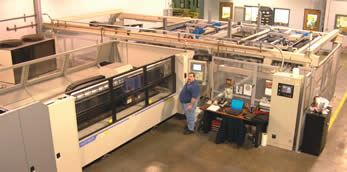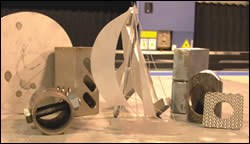Laser Facilitates Quicker, Thicker Cutting
Tornqvist, Inc., established in 1876, manufactures component parts for the industrial, architectural and pharmaceutical industries. Three years ago, the Wayne, New Jersey company moved into a new 27,500-square-foot facility to accommodate its steady increase in business. This relocation was a crucial step in preparing for a successful future, says Ken Grimbilas, vice president of the business since his family assumed ownership in 1986.
Share





Tornqvist, Inc., established in 1876, manufactures component parts for the industrial, architectural and pharmaceutical industries. Three years ago, the Wayne, New Jersey company moved into a new 27,500-square-foot facility to accommodate its steady increase in business. This relocation was a crucial step in preparing for a successful future, says Ken Grimbilas, vice president of the business since his family assumed ownership in 1986.
With 22 employees, the company operates one and a half shifts, 5 to 6 days a week. The shop’s extensive list of equipment includes a laser, shears, brakes, turret punch presses, single-end punches, drills, saws and plate rolls. The company performs multiple operations, including welding—mig, tig, stick, spot and submerged—grinding, sanding, polishing, custom finishing and machining (milling, turning, tapping and inspection). These considerable in-house capabilities, according to Tornqvist, allow the shop to offer customers quick turnarounds, which earns repeat business.
Mr. Grimbilas describes the shop’s purchase of its first laser, an Amada LC667, as a gamble. However, the purchase was well worth the initial anxiety associated with integrating it.
“When compared to the results we were achieving on punch presses, it allowed us to accelerate operations while enhancing versatility for our customers,” he says.
Fifteen years later, the company was ready to penetrate new markets and upgrade its equipment. Although Tornqvist had relied on the Amada every day for more than 15 years, the company realized that it was time to modernize.
Meticulous in its approach, the company assembled a six-page spreadsheet that outlined the statements made by virtually every laser manufacturer. Tornqvist also posed questions, asking each manufacturer to explain why its technology was superior and then cross-referenced statements. After 18 months of researching virtually every laser manufacturer and machine on the market, Mr. Grimbilas selected a 3718LVP-40CFX with MSCIII automation from Mitsubishi Laser (Wood Dale, Illinois).
“One of the main things that sold me on Mitsubishi was the professionalism of the company’s sales representatives,” he explains. “The staff of Paradigm Metalworks, Mitsubishi’s north Jersey dealer, was very patient and thorough with me. If they didn’t immediately know the answers to my questions, then they’d get back to me or connect me with a technician who could assist me.”
The simplicity of the laser’s resonator was also a determining factor, says Mr. Grimbilas. “When we lifted the hood of other machines we checked out, it looked like some elaborate science project,” he explains. “Mitsubishi’s system was not intimidating. Instead of a root blower, it has three small fans. The company’s approach is completely different.”
Tornqvist cites major advantages of the new system as increased capacity and more versatility related to thicknesses and types of material. The company has found that the LVP generates 50 percent more output than the old laser. For instance, when machining 1/4-inch mild steel on the previous machine, the company was able to achieve feed rates of 60 to 80 ipm. Using the new laser, Mr. Grimbilas speculates feed rates of around 150 ipm are achieved. Aside from noticing faster overall speeds, the company is also impressed with the new machine’s startup.
“Startup with our old machine took about 45 to 60 minutes,” says Mr. Grimbilas. “We are now cutting parts within 10 minutes. With the LVP, switching materials is also easier and faster, too.”
Mr. Grimbilas relays another benefit of implementing the system: “Change-over once required as much as 1 hour,” he says. “Today, we’re able to switch materials and thicknesses within minutes.”
Tornqvist says it wanted a laser that would separate the company from the competition by cutting faster and thicker. The LVP-40CFX’s capabilities of cutting as much as 1-inch hot rolled steel, 1/2-inch stainless and 3/8-inch aluminum has enhanced the company’s ability to accommodate current customers and attract future ones.
Mitsubishi’s EL4 automation has had the biggest impact on the company’s production. The shop says it no longer needs to be manually controlled all of the time, so production continues during breaks and between shifts.
“Our productivity has reached an all-time high,” says Mr. Grimbilas. “We can just program the laser and load it up with material at night. It will then run lights-out until the job is finished.”
In addition to faster cutting speeds and quick change-overs, the machine’s heavier capacity, load/unload unit and round-square-rectangle tube cutting capabilities have allowed the company to fulfill its goal of reaching out into newer markets and expanding within existing markets.
Mr. Grimbilas isn’t planning on slowing down any time soon; he will continue to make strides to move the company into the future.
Read Next
5 Rules of Thumb for Buying CNC Machine Tools
Use these tips to carefully plan your machine tool purchases and to avoid regretting your decision later.
Read MoreSetting Up the Building Blocks for a Digital Factory
Woodward Inc. spent over a year developing an API to connect machines to its digital factory. Caron Engineering’s MiConnect has cut most of this process while also granting the shop greater access to machine information.
Read MoreBuilding Out a Foundation for Student Machinists
Autodesk and Haas have teamed up to produce an introductory course for students that covers the basics of CAD, CAM and CNC while providing them with a portfolio part.
Read More
























.jpg;maxWidth=300;quality=90)



